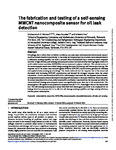The fabrication and testing of a self-sensing MWCNT nanocomposite sensor for oil leak detection
| dc.contributor.author | Al-Bahrani, M | |
| dc.contributor.author | Bouaissi, A | |
| dc.contributor.author | Cree, Alistair | |
| dc.date.accessioned | 2022-06-21T11:11:49Z | |
| dc.date.available | 2022-06-21T11:11:49Z | |
| dc.date.issued | 2022-04-26 | |
| dc.identifier.issn | 1748-1325 | |
| dc.identifier.issn | 1748-1325 | |
| dc.identifier.uri | http://hdl.handle.net/10026.1/19334 | |
| dc.description.abstract |
<jats:title>Abstract</jats:title> <jats:p>Oil spillage, due to either direct or indirect accidents, can cause major environmental and economic issues if not detected and remedied immediately. In this study, the unique properties of carbon nanotubes have shown a substantial sensing capability for such a purpose when incorporated into a nanostructured composite material. A high-efficiency self-sensing nanocomposite sensor was fabricated by inserting highly conductive multi-walled carbon nanotubes (MWCNTs) into an elastomeric polymer substrate. The microstructure of the nanocomposite sensor was studied using scanning electronic microscopy and Raman spectroscopy. The response rate of the sensor was evaluated against different MWCNT concentrations, geometrical thickness and applied strains (causing by stretching). The results indicated that the response rate of the sensor (β) decreased with increasing MWCNT concentration and showed the strongest response when the sensor contained a 1.0 wt % concentration of MWCNTs. Additionally, it was found that the response time of the self-sensing nanocomposite sensors decreased in keeping with decreases in the sensor thickness. Moreover, when the sensor was subjected to strain, while immersed in an oil bath, it was found that the response rate (β) of the unstretched self-sensing nanocomposite sensor was significantly lower than that of the stretched one. The sensors given a 3% applied strain presented a response rate (β) ≈ 7.91 times higher than of the unstretched one. The self-sensing nanocomposite sensor described here shows good potential to be employed for oil leakage detection purposes due to its effective self-damage sensing capability and high sensing efficiency and low power consumption.</jats:p> | |
| dc.format.extent | 622-629 | |
| dc.language | en | |
| dc.language.iso | en | |
| dc.publisher | Oxford University Press | |
| dc.subject | Bioengineering | |
| dc.subject | Nanotechnology | |
| dc.title | The fabrication and testing of a self-sensing MWCNT nanocomposite sensor for oil leak detection | |
| dc.type | journal-article | |
| dc.type | Journal Article | |
| plymouth.volume | 17 | |
| plymouth.publication-status | Published | |
| plymouth.journal | International Journal of Low-Carbon Technologies | |
| dc.identifier.doi | 10.1093/ijlct/ctac044 | |
| plymouth.organisational-group | /Plymouth | |
| plymouth.organisational-group | /Plymouth/Faculty of Science and Engineering | |
| plymouth.organisational-group | /Plymouth/Faculty of Science and Engineering/School of Engineering, Computing and Mathematics | |
| plymouth.organisational-group | /Plymouth/REF 2021 Researchers by UoA | |
| plymouth.organisational-group | /Plymouth/REF 2021 Researchers by UoA/UoA12 Engineering | |
| plymouth.organisational-group | /Plymouth/Users by role | |
| plymouth.organisational-group | /Plymouth/Users by role/Academics | |
| dcterms.dateAccepted | 2022-03-23 | |
| dc.rights.embargodate | 2022-6-22 | |
| dc.identifier.eissn | 1748-1325 | |
| dc.rights.embargoperiod | Not known | |
| rioxxterms.versionofrecord | 10.1093/ijlct/ctac044 | |
| rioxxterms.licenseref.uri | http://www.rioxx.net/licenses/all-rights-reserved | |
| rioxxterms.type | Journal Article/Review |


